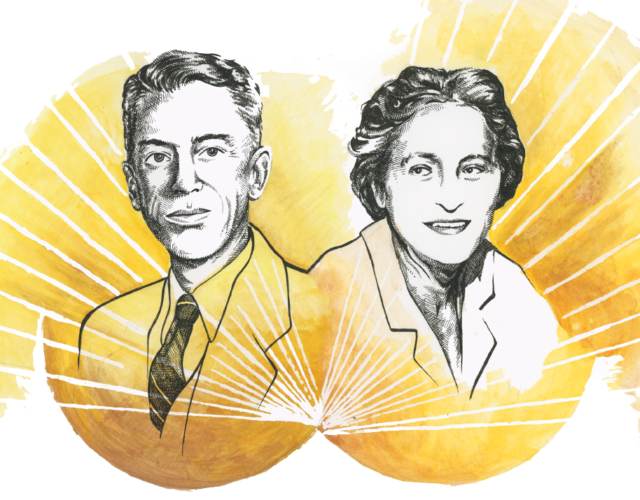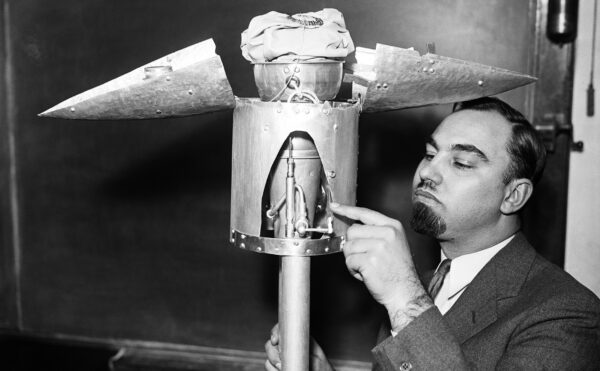Before the bad blood and competition, before he agitated for her dismissal and her fame eclipsed his, Hoyt Hottel and Maria Telkes had been colleagues pursuing a common goal: to find new ways to use the energy radiated by the sun.
Working together at MIT in the 1940s, they wrestled with basic questions solar engineers continue to confront. How can sunlight be efficiently converted into other forms of energy? How can the resulting heat or electricity be stored and put to use? Can solar technologies produce energy cheaply enough to be useful in everyday life and supplant the world’s finite supplies of polluting fossil fuels?
Many Americans were particularly enthralled by the idea of using the sun to warm their homes. The prospect of free heating proved irresistible to a generation that had learned hard lessons about scarcity and thrift as they endured the Great Depression, wartime fuel rationing, and oil panics. A few enterprising architects had already garnered attention for building so-called passive solar houses, which used walls of south-facing windows to maximize the homes’ warmth in winter.
“No idea of the last 30 years has so fired the imagination of the American public as the one of letting the old sol reduce the winter fuel bill,” declared a 1942 article in House Beautiful.
As interest grew at academic institutions and in private industry, scientists began designing materials and systems to better capture solar energy. Among the many animated by the idea of exploiting the sun’s seemingly endless bounty was Godfrey Lowell Cabot, an industrialist from an old Boston Brahmin family. Cabot had grown very wealthy manufacturing the carbon black used to strengthen and extend the life of car tires. In his later years he became obsessed with energy and solar energy in particular, funding research at both Harvard University and MIT.
“Godfrey Lowell Cabot of Boston speaks to almost anybody, but his thoughts are definitely heavenward,” Time reported in 1938, soon after Cabot gave MIT a sizable donation. “He is 77, and in his old age he broods much about the vast stores of energy in sunlight which man does not utilize.”
In 1939 MIT hired Telkes, a Hungarian immigrant and one of the very few women in engineering, to join its nascent solar program. Like Cabot she was a fervent believer in solar energy’s potential to replace potentially limited fossil fuels, such as coal and gas. Solar energy, she once wrote, “is the greatest untapped energy resource of the world and its utilization should be one of our most important and fruitful projects.” She was later dubbed the Sun Queen for her many groundbreaking solar inventions.
Hottel, a chemical engineering professor and the leader of MIT’s solar project, was far more skeptical of the technology’s prospects. More than once he criticized its proponents for what he considered fuzzy-headed optimism. He clashed with Cabot and Telkes, eventually driving her from the program. Yet, paradoxically, he too was a foundational figure in the field. He published seminal research and built some of the world’s first-ever “active” solar houses.
The story of these scientists, their collaborations, and their clashes captures the history of a simple idea that proved difficult to realize in full but had the potential to fundamentally change the way we live.
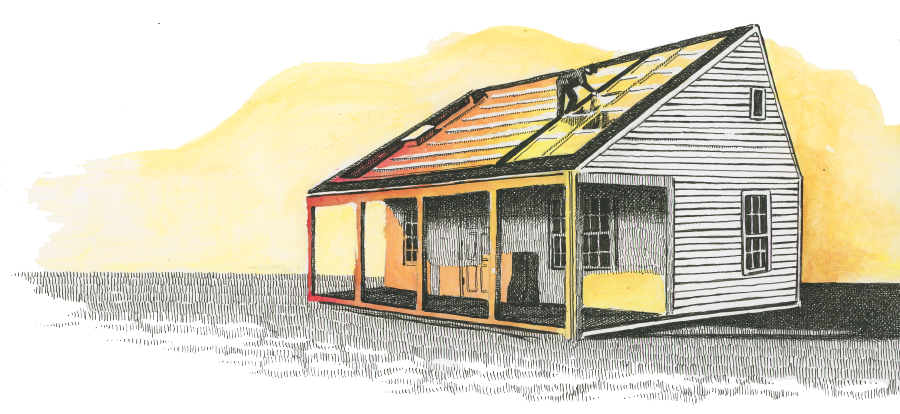
A Home to Live In
Hottel came to solar technology almost by accident. A prodigy from Indiana, he graduated from college at 19 and became an assistant professor at MIT at 25. He mostly studied fire and industrial furnaces but was asked to help launch the solar project. He was the only participant who came up with a concrete proposal and so, as he later recalled, was made “the rather too-young chairman” of MIT’s solar energy committee.
Hottel spent some of Cabot’s riches studying flat-plate collectors, simple glass-covered devices often used in California and Florida to produce hot water for homes. The first product of that research was an experimental structure erected on the MIT campus in 1939. Later dubbed MIT I, Hottel’s first solar house featured a rooftop collector where sunlight heated the water, which was then stored in a huge underground tank. Fans blew air over the hot tank and up into the building, keeping it warm through two Boston winters.
A 1942 paper Hottel cowrote on the project became a classic in the field of solar heating and a guide for use of flat-plate collectors, influencing engineers and do-it-yourself homebuilders for decades to come. Not that anyone would want to exactly replicate MIT I; as Hottel was careful to explain, it was a scientific experiment and not a test model. Installing a 17,000-gallon underground tank would not be economically feasible for a real house.
Yet real sun-heated houses were what the public increasingly wanted. Now that Hottel understood how to collect solar energy, he recognized that MIT needed to develop a more practical storage solution, perhaps a smaller tank that kept just a day’s supply of heated water. For Telkes this problem created her first opportunity to work on solar housing.
Telkes had come to the field in a roundabout way, having first dabbled in biological and metallurgical research related to energy. After immigrating to the United States in 1924, she worked as a biophysicist at the Cleveland Clinic Foundation, where she helped surgeon George Washington Crile create a photoelectric device that recorded brain waves. In Crile’s darkened lab “brain tissues were made to glow by their own inner light, giving off a strange radiance that shown like a mystic halo,” the Chicago Daily Tribune reported in 1934.
Telkes next worked at Westinghouse developing metal alloys for thermocouples that would turn heat into electricity. When she heard about MIT’s new solar-energy program, she wrote the university to ask for a job and was hired. With the outbreak of World War II she was assigned to work with Hottel designing a portable solar desalinator, a balloon-like device that aviators downed at sea could use to make drinkable water.
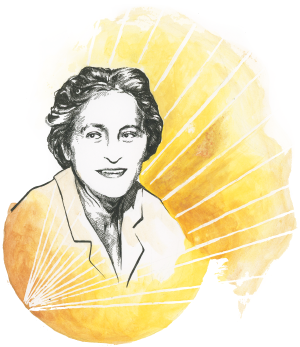
She also continued tinkering with thermocouples. A 1942 profile of Telkes in the Christian Science Monitor found her stirring solutions over a flame in an MIT lab and demonstrating a visionary assertiveness. “It is the things supposed to be impossible that interest me. I like to do things they say cannot be done,” she told the newspaper.
By the end of the war she added another focus to her research, becoming deeply engaged in the challenge of designing practical solar-heating systems. “Solar heat storage,” she later wrote in Science, is “the critical problem.”
Water, which could only store so much heat per gallon, required large, expensive tanks, Telkes reasoned. Solid materials such as rock were even less efficient. More promising were phase-change materials that absorb or release heat when they change from solid to liquid. She became fascinated with one such substance called Glauber’s salt, or sodium sulfate, which is widely used in the chemical industry.
For MIT’s next solar experiment Hottel initially wanted to build a real house with occupants. Telkes proposed putting containers of Glauber’s salt behind a glass wall, where they would absorb large amounts of heat during the day and release it as the building cooled.
“The idea looks very good,” Hottel wrote in response to her proposal. “Dr. Telkes’ contribution may make a big difference in the outcome of our project.”
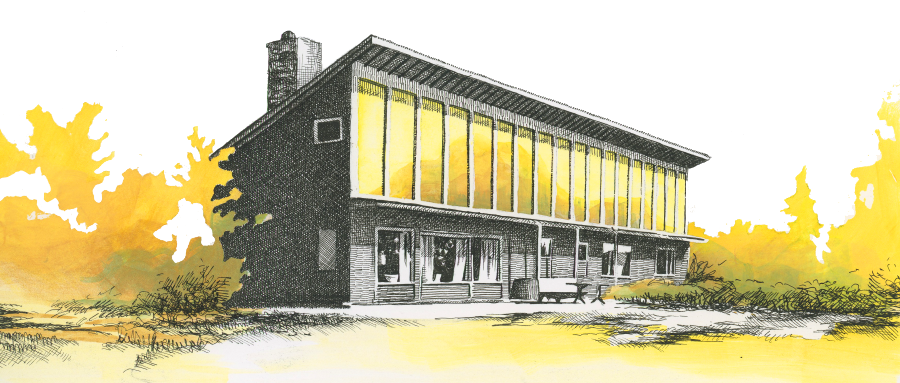
Clashing Worldviews
Hottel and Telkes both aspired to build a livable solar house, but they approached the idea from very different perspectives.
While Hottel would go on to lead MIT’s solar team for more than two decades, solar housing was just one of many different projects he worked on. Like many academic scientists, he accepted a variety of research tasks as they were offered by corporate or government sponsors. He studied ramjet engines and built a device to remove carbon monoxide from auto exhaust; during World War II he worked on tank-mounted flamethrowers and napalm bombs. He once developed a simulated skin to gauge the effect of atomic blasts on the body.
Hottel approached solar-energy collection as just another engineering and economic problem rather than as a societal imperative. He frequently expressed skepticism about its prospects, given the world’s ample supply of relatively cheap fossil fuels and the emergence of nuclear power, and he mocked those who cited the seemingly vast amount of energy available in sunlight.
“Figures such as these are almost irrelevant to the problem of practical utilization of solar energy,” he said in a 1940 lecture. “They have attracted uncounted crank inventors who have approached the problem with little more mental equipment than a rosy optimism.” In reality the amount of useful sun energy is limited by the weather and inefficiencies in energy collection, he explained.
Why Hottel continued to pursue solar experiments for years despite his belief in their ultimate futility is not entirely clear. He was surely driven in part by his restless scientific curiosity and industrious personality, as well as ambitions to break new ground, as he did with MIT I. Heading a well-endowed research group, especially at such a young age, also carried a measure of prestige and may have helped cement his position at MIT.
Cabot’s solar grant funded Hottel’s and his graduate students’ research and helped them produce many scientific papers, a key measure of success. Academics are always on the hunt for funding; it would have made little sense for him to give up control of a well-resourced, long-lasting research opportunity, especially one that let him craft his own experiments rather than follow the dictates of corporate sponsors. Once launched, the solar fund just kept going, even if Hottel’s interest waned at times and MIT ultimately judged the program underproductive.
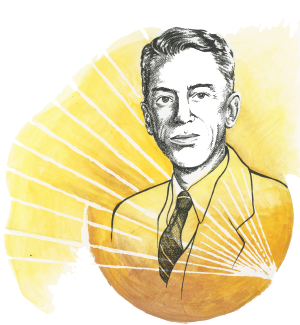
Hottel sometimes sneered at breathless articles on solar houses, but he also may have enjoyed the greater public attention the projects attracted compared with his other work. Newspaper and magazine interviews gave him venues to demonstrate his hard-nosed fidelity to scientific and economic rigor.
“He clearly took pride in his role as a skeptic, and believed he was making a contribution by broadcasting caution,” writes architectural historian Anthony Denzer.
Telkes, meanwhile, squarely saw the exploitation of solar energy as a benefit to mankind, allying herself with Cabot and with such prominent advocates as scientists Farrington Daniels and Eugene Ayres. Unlike Hottel, Telkes would spend the rest of her career studying, proposing, or building solar-energy projects, and she vigorously defended their prospects against skeptics like him.
“Conservative engineers treat this subject with near derision,” she wrote in a 1951 paper. She likened them to people who had preferred horses to early automobiles, focusing too much on tangible, short-term results over the likely long-term benefits. Yes, the United States had access to plenty of fuel, but what about places lacking in coal or oil? What about the “soot, fire hazards, and mining accidents” caused by the production and use of conventional fuels?
Solar energy is “the cleanest and healthiest fuel,” she wrote. While the field still faced many challenges, “The total research and development expenditures made thus far in solar energy utilization are infinitesimal when compared with the expenditures made in the development of other natural resources. Sunlight will be used as a source of energy sooner or later anyway. Why wait?”
It was perhaps inevitable that Hottel’s and Telkes’s ideological differences would eventually make them adversaries. The seeds of the conflict, however, may have been planted early on, during Telkes’s first project for the team.
Telkes had completed a prototype of her desalination device for aviators in 1942 and won notice from government officials and private industry. But Hottel changed manufacturers three times to get the best deal and minimize costs, delaying delivery of the desalinators to the U.S. military until just after the end of the war. Telkes and Cabot expressed frustration that Hottel’s maneuvers had rendered the project much less useful than it might have been.
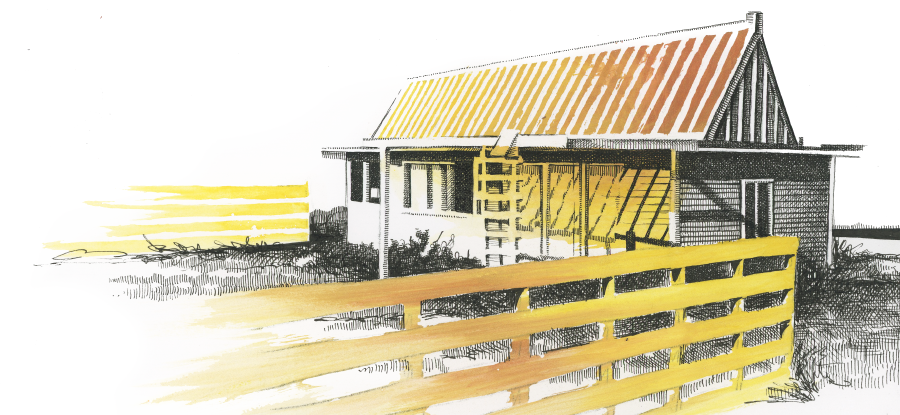
Brilliant Disasters
If Hottel’s mishandling of the desalinator set the two engineers at odds, it was Telkes’s obsession with Glauber’s salt that would trigger a permanent rupture. Though initially promising, the substance turned out to be troublesome. During testing for the team’s second solar house in 1946, the material stratified into its different component substances and corroded the containers until they leaked.
Hottel and others blamed Telkes for “imprecise assessment” of the heat storage process, historian Daniel Barber writes. Telkes blamed Hottel for poorly supervising the graduate students who ran the experiment, saying they had failed to keep the building at a steady temperature as required. Her colleagues also clashed with Telkes on a personal level, in part because of her assertive personality but also, perhaps, because of a bias against the sole woman on the team.
She is “a person of strong opinions which she expresses forcibly,” MIT dean George Harrison wrote in a report on the solar fund several years later. Even people outside the program “found it impossible to agree with her for any length of time.”
MIT President Karl Compton took Telkes’s side in the squabble over the Glauber’s salt testing. “She does not like to see her ideas brushed aside based solely on this evidence,” he wrote to Hottel. He urged the solar committee to skip further testing and have an architect design a livable house with phase-change technology. “We should make a bold approach for a further big step forward in the matter of the solar heated house, rather than putter around with further measurements.”
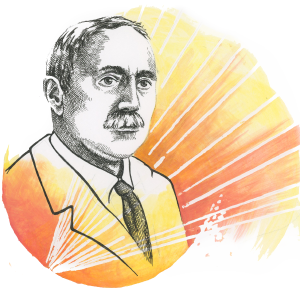
But despite support from Compton and from Cabot, who had become friendly with Telkes, Hottel not only rejected the idea of using Glauber’s salt but dismissed Telkes from the solar energy fund entirely. Telkes was reassigned to MIT’s metallurgy department, where she resumed her research on thermocouples.
Instead of building a real house Hottel and the others put up another experimental shed, MIT II. It was made up of several adjoining cubicles, each with a different arrangement of glass windows, walls of water-filled containers, and other elements.
The water walls actually did a decent job of storing heat. (Decades later the idea would be taken up again by solar-home builders.) But Hottel believed the building’s leaky windows had let out too much heat, basically ruining the project, and he apparently disowned it, according to Denzer. Cabot was again annoyed and suggested Hottel should be removed as chair of the solar energy fund in favor of someone who would go ahead and build a real house—someone like Maria Telkes.
“I would like to see this solar energy research entrusted to someone who would give more attention to it,” he groused.
Hottel recognized the threat. If an occupied house was the price of remaining in charge of the fund, he was ready to provide one. He and a collaborator, architecture professor Lawrence Anderson, moved quickly this time. They had an architecture student design a plan to convert MIT II into MIT III, a habitable house that used Hottel’s rooftop collector method.
With a peaked roof, a backyard, and a water tank hidden in the attic, the structure looked like a typical house. It immediately drew national attention. In 1949 the Saturday Evening Post profiled the occupants—graduate student Harry Reid; his wife, June; and their two-year-old son, Toby—“who were elated with the house and eminently satisfied with its heating system,” according to Barber.
“None of us has had a cold since we moved in, and Toby hasn’t even had the sniffles,” June was quoted as saying.
At peak performance MIT III derived 82% of its heat from the sun and the rest from auxiliary heaters. Various inefficiencies kept it from achieving the builders’ goal of 90% solar heating, but the project confirmed the accuracy of Hottel’s earlier work on flat-plate collectors and boosted his public profile.
“Hottel executed a brilliant subterfuge, using the architecture department and the Reid family to create an attractive Trojan horse which would accommodate his experiment and distract from controversies about his leadership,” Denzer writes in The Solar House, a history of passive and active solar homes.
Telkes, though exiled from the solar energy fund, continued to look for opportunities to prove the utility of Glauber’s salt. She befriended a well-known modernist architect, Eleanor Raymond, who eventually put her in touch with Amelia Peabody, another wealthy Boston Brahmin. With encouragement from close friends Godfrey Cabot and Karl Compton, Peabody agreed to commission Telkes and Raymond to build a solar house on her estate in Dover, Massachusetts.
Shortly after the debut of MIT III, the three women completed their Dover Sun House. Described in the press as looking like “an overgrown chicken coop,” it was dominated by a giant attic with a south-facing wall composed entirely of tall, glass-plated collectors. For heat storage warmed air was blown into spaces containing 3,500 gallons of Glauber’s salt housed in metal drums.
The project appeared a huge success. Cousins of Telkes’s lived comfortably in the building for two winters, and front-page newspaper articles celebrated the house for dispensing entirely with conventional heating fuels. “A New House in Dover, Mass., Has Been Comfortably Warm All Winter Without a Furnace,” read a 1949 headline in Life. A cover story in Popular Science said the house might represent a more important scientific development than the atom bomb. Andrew Nemethy, who grew up in the house, later recalled that it drew 3,000 visitors—“society matrons, club members, reporters, and curious civilians”—until tours were suspended.
“No other solar house received as much publicity as the Dover Sun House,” Denzer notes.
The glowing reports missed a few important details, however. While the house did not use coal or oil for heating, the fans needed to circulate air ran up the electric bill. And as it had during the MIT tests, the Glauber’s salt stratified into liquid and solid layers, and the metal containers corroded and leaked. By the third winter Nemethy’s family was freezing.
“After week-long strings of cloudy days, indoor temperatures sank to panic levels. My mother complained, and we soon had electric heaters in all the rooms,” he recalled. The solar heating system was removed, and an oil furnace was later installed in the attic.
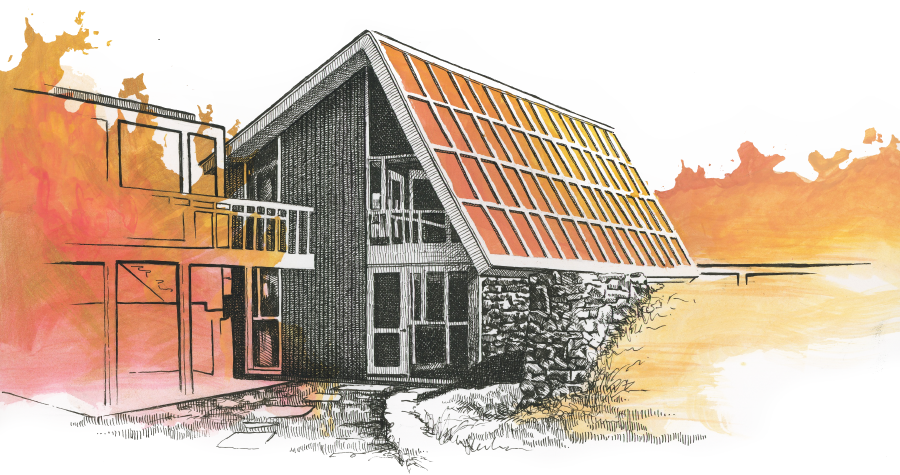
Prejudice and Persistence
After MIT III the solar energy fund went dormant. In 1953 dean Harrison undertook a review to understand why it was not more productive. His report briefly mentioned Hottel’s spotty leadership but largely took the professor’s side, laying much of the blame on meddling by Cabot under the influence of Telkes.
The review heavily reflected Hottel’s perspective, according to historian Sara Shreve. Hottel was hostile toward Telkes from early on because of her tenacious commitment to the idea of solar housing as well as her eagerness to engage with the public and the press. The report even went as far as disparaging Telkes’s intellect and character.
“She has a wide circle of influential acquaintances, who are impressed with her enthusiasm for solar heating and her apparent intelligence,” Harrison wrote. She supported outside experiments (namely, the Dover Sun House) that “proved to be either grossly over-engineered or to be failures.” This is the report that described Telkes as having strong opinions that she expressed “forcibly” and that stated several people had found it “impossible to agree with her.”
“She has for some time been at outs with the Committee, and especially with Professor Hottel,” Harrison wrote.
For Shreve these criticisms reveal an underlying sexism. The “assertiveness” that a woman would need to earn a doctorate in engineering in Hungary in the 1920s, emigrate to the United States, and get a job at MIT “were at odds with prevailing societal expectations about female behavior,” she writes, especially in the post–World War II return to traditional gender roles.
Barber notes that the dean cites Telkes’s “rather radical opinions” and supposed “ultra-radical tendencies.” These comments describe her solar advocacy but may also betray Harrison’s suspicions of a Hungarian woman amid the McCarthyist anti-Communism of the early 1950s.
After the review MIT fired Telkes. Hottel and Anderson made one more big solar-housing push, building a home in Lexington, Massachusetts, that was meant to be sold on the open market. The main distinguishing feature of MIT IV was a large wall of solar collectors that sloped down from the top of the roof to a high berm behind the house.
The house made the cover of Popular Mechanics, but it was burdened by complex systems: multiple water tanks, a forced-air system, and automated controls designed to turn on the solar collection only when it offset the cost of pumping the water. MIT staff struggled to keep up with repairs and maintenance, and nobody would buy the home. Denzer calls the structure “a public relations success, a noteworthy aesthetic effort, an inefficient machine, and an economic tragedy.” After four years the solar system was ripped out.
Hottel quit trying to build solar housing. While a number of scientists, architects, and do-it-yourselfers built innovative and successful solar homes in the ensuing decades—using a wide variety of both active and passive designs—Hottel remained a skeptic until the end of his life. In a 1995 interview he said he favored continued solar research and believed photovoltaic panels would eventually prove valuable, but he still thought people were far too optimistic about solar energy.
“We’re kidding the public about the sun. It’s not worth as much as claimed,” he said in a 1985 oral history interview with the Chemical Heritage Foundation (now the Science History Institute). “The cost of doing something using the sun has always been a little higher than if you do it some other way.” Nonetheless, when he died in 1998, the New York Times described him as “a leader in the development of alternative fuels.”

Telkes, meanwhile, became a star in the lively but increasingly irrelevant world of solar-heating research, which gradually faded in prominence as nuclear power and cheap Middle Eastern petroleum conquered the energy industry. She presented at conferences and proposed a version of the Dover Sun House for Manhattan, which won her a job at New York University.
She kept busy, consulting on the construction of several homes around Princeton, New Jersey, and helping plan residential developments in upstate New York and the Dallas suburbs. (Neither of the developments was built.) In the late 1950s she designed an ambitious demonstration project, the Princeton Sun House, using Glauber’s salt, but it was plagued with the usual corroding containers and other problems and never worked very well. Another project, a stand-alone heat generator called the Solar Wall, didn’t go anywhere.
After briefly teaching at the University of Pennsylvania and working in industry, she found a home at the University of Delaware, where she expanded her research to include a new breed of solar technology—electricity-generating photovoltaic cells. In 1971 she and her colleagues built Solar One, the first house to generate both heat and electricity from the sun, helping kick off a nationwide solar boom.
By the time photovoltaic solar panels entered the market, the active heating systems that Telkes, Hottel, and many others designed had largely faded away. They had become technological dead-ends. Just a few examples of these systems survive in homes custom-built by tinkerers and home-efficiency enthusiasts.
In that respect Hottel was right: it was always going to be a little cheaper (not to mention easier) to use some other fuel to create heat. Solar methods did not get good enough fast enough to meet the demands of the massive housing boom of the 1950s and 1960s, which erected millions of tract homes heated by gas radiators and cooled by electric air conditioners. The federal government and the energy industry spent billions promoting traditional fuels, sweeping solar heating aside.
But in another way Hottel was wrong to foreclose the possibilities of solar heating, and Telkes deserves the praise she received for her determined prescience and eagerness to innovate.
Mid-century solar houses were less expensive to heat than conventional homes, some by a large margin. They also had environmental benefits whose significance was not fully appreciated until half a century later, when the threat posed by greenhouse gases became widely known. With well-sealed windows and better insulation, homes can be made even more efficient, as builders of today’s highly insulated “passive houses” have shown. Telkes was on the right track, but the technological and social transformations she sought were just out of reach.

